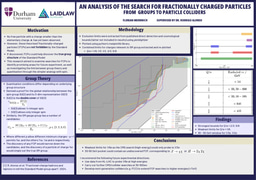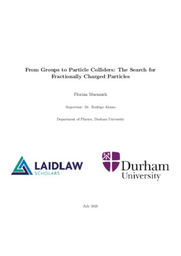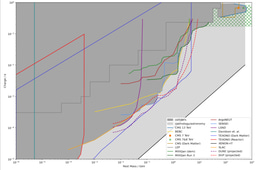Reasearch Proposal - An Analysis of the Search for Fractionally Charged Particles

INTRODUCTION AND BACKGROUND
For over a century, physicists have been trying to discover, examine and categorise 'fundamental' particles (the smallest building blocks in nature). Since its conception in the mid-20th century, the Standard Model of Particle Physics has been refined and improved, with continual discoveries of new particles, such as the Higgs Boson and Top Quark, providing experimental evidence supporting this model. It is the most successful theory of fundamental particle physics we have. Nevertheless, it is far from a complete theory, and we still don't understand some very fundamental questions - we can't explain why there's so much more matter than anti-matter, and the standard model is not compatible with our best theory of gravity.
The Standard Model includes three of the four fundamental forces: electromagnetism, and the weak and strong forces. Each force has a characteristic called its ‘group structure’ which, in essence, describes how the force acts. The standard model has its own overall group structure, which is some combination of the three individual ones. However, we still don’t understand exactly what this combination is.
One approach to uncovering this group structure is to search for fractionally charged particles. So far, the smallest charge we have observed is the charge of an electron, denoted 1e. However, some group structures would allow for particles with charges as small as 1/3e, or even 1/6e - fractionally charged particles (FCPs). Finding FCPs would allow physicists to get closer to or potentially pinpoint the true group structure of the Standard Model (Alonso et al, 2024)
The primary objective of this project would be to construct a general overview of the search for FCPs, presented in graphical form. This could serve as a tool to be consulted by researchers, saving time trawling through countless individual papers and helping to direct future experiments. Beyond the immediate academic community, this search for FCPs could have a number of real-world benefits. One of the likely outcomes of my project is to recommend searching at higher energies, which would require renewed innovation in particle collider technology. Innovation in particle colliders has already contributed direct, positive impact in medical technology (PET scanning, radiotherapy, etc. for the treatment of over 30 million people) (FERMILAB), while computing technology developed at CERN has been applied to monitoring air pollution (CERN). I hope that my research could feed in to similar future innovations with social impact.
RESEARCH QUESTIONS
1. What charge and mass values have the results of collider experiments already discounted?
2. What regions of mass and charge have not yet been explored?
3. What methods are best suited for exploring these regions?
4. What could potential discoveries of new particles in those regions suggest about the group structure of the Standard Model?
METHODOLOGY
In order to obtain a broad picture of the search for FCPs so far, I would use existing data from a number of past experiments. I have chosen to focus primarily on results from particle colliders as they constitute the majority of the existing literature and are generally seen as the most promising method for finding FCPs. Given enough time, I would like to include results from astronomical experiments, as they may be able to search at very high energies, beyond the scope of particle colliders (Perl et al., 2009).
Experiments look for certain charges at certain masses, dictated by the amount of energy put into the collision. Therefore, each experiment examines only a narrow range of masses. In order to provide a more general overview of the search for FCPs so far, I would collate data from numerous experiments, constructing an exclusion plot of charge against mass. I would use the plot to identify areas of charge and mass that have not yet been discounted by experiment, indicating that they could give rise to fractionally charged particles. I could also identify the methods that are best suited to explore these areas. Given the potential the report has to inform future experiments into FCPs, my intention is to share my conclusions with the relevant research institutions.
Beyond this, I aim to link my experimental conclusions back to the theory underpinning the Standard Model: I hope my research might enable me to propose the most likely candidate for the group structure of the standard model.



Please sign in
If you are a registered user on Laidlaw Scholars Network, please sign in